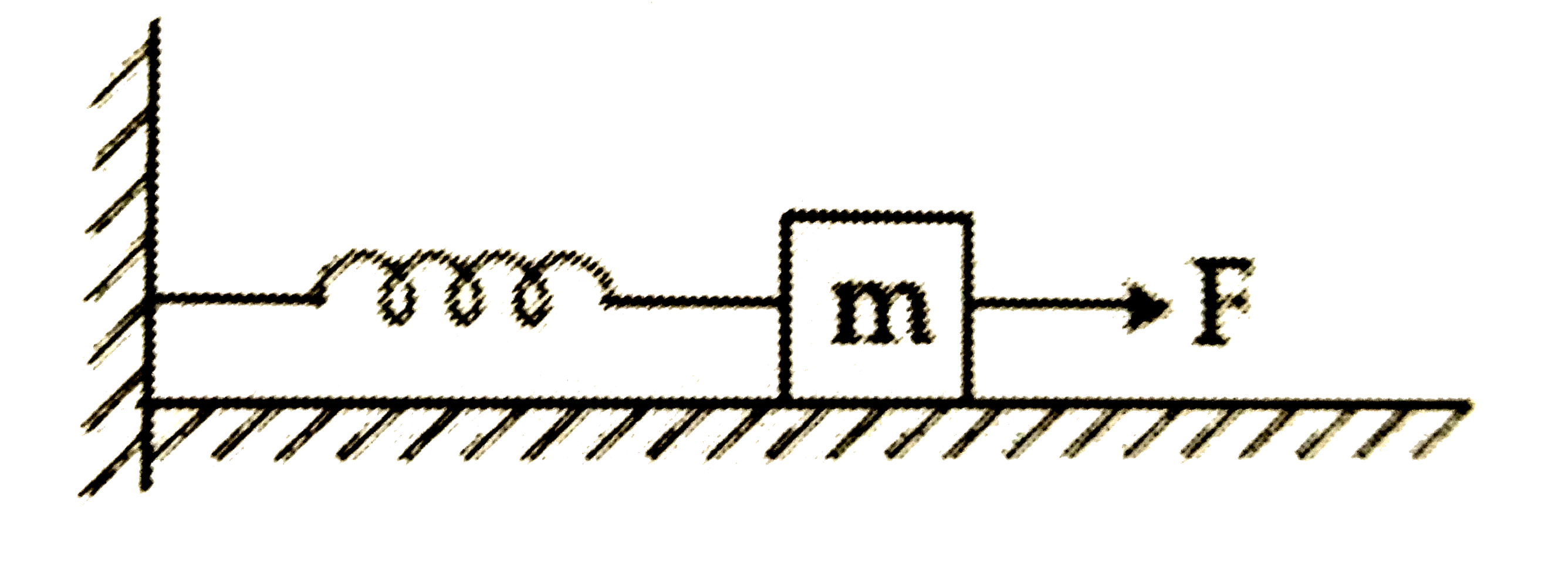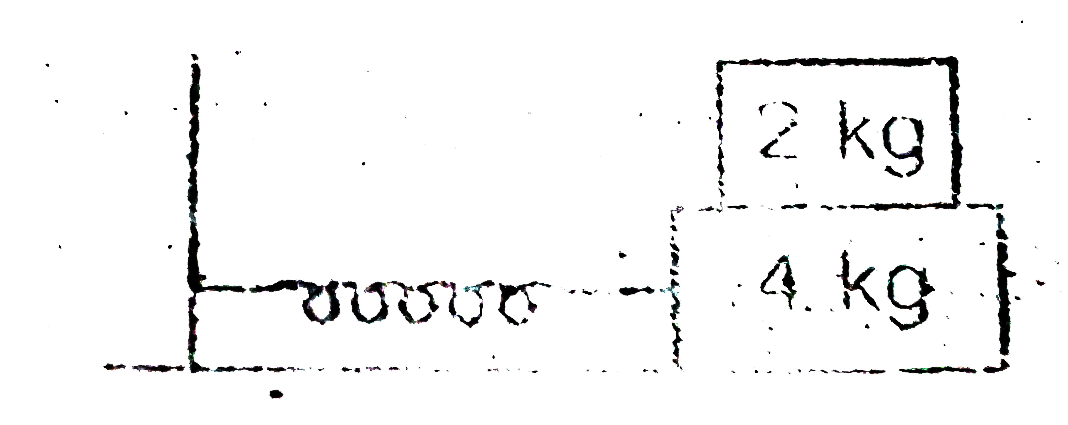As shown in figure a block A having mass M is attached to one end of a mass less spring. The block is on a friction less horizontal surface and the free end of the spring is attached to a wall. Another block B having mass ‘m’ is placed on top of block A. Now on displacing this system horizontally and released it executes S.H.M. What should be the maximum amplitude of oscillation so that B does not slide off A ? Coefficient of static friction between the surfaces of the blocks is μ.A Amax = {μmg / k}B Amax = [{μgM + m}/k]C Amax = [{μM – mg}/k]D Amax = [{2μM + m}/k]
The correct option B Amax = [{μgM + m}/k]Explanation:ω2 = k/m ----- formulahere ω2 = [k/{M + m}] 1To prevent B from sliding off A the maximum force acting on B should notbe more than frictional force μmg.∴ fmax = mamax = mω2 Amax 2from 1 & 2fmax = m Amax [k/M + m} fmax = {km/M + m} AmaxTo prevent block from sliding fmax = μmghence {mk Amax/M + m} = μmg∴ Amax = [{μgM + m}/k]
Related Solutions
A block of mass m is attached to one end of a mass less spring of spring constant k. the other end of spring is fixed to a wall the block can move on a horizontal rough surface. The coefficient of friction between the block and the surface is mu then the compession of the spring for which maximum extension of the spring becomes half of maximum compression is .
View SolutionA block of mass m is attached to one end of a mass less spring of spring constant k. the other end of spring is fixed to a wall the block can move on a horizontal rough surface. The coefficient of friction between the block and the surface is mu then the compession of the spring for which maximum extension of the spring becomes half of maximum compression is .
View SolutionA block of mass m, lying on a smooth horizontal surface, is attached to a spring (of negligible mass) of spring constant k. The other end of the spring is fixed, as shown in the figure. The block is initally at rest in its equilibrium position. If now the block is pulled withe a constant force F, the maximum speed of the block is :
View SolutionA block of mass m, lying on a smooth horizontal surface, is attached to a spring (of negligible mass) of spring constant k. The other end of the spring is fixed, as shown in the figure. The block is initally at rest in its equilibrium position. If now the block is pulled withe a constant force F, the maximum speed of the block is :
 View Solution
View SolutionApplying a horizontal force F to one end of a rope of mass m, a block of mass M attached to the other end is being pulled on a non-friction horizontal surface. The force applied to the block by the rope-
View SolutionA block of mass m is connected with another block of mass 2m kept on a rough horizontal table by means of an ideal spring of spring constant K and a massless string as shown in the figure. The minimum coefficient of friction between the block of mass and the table so that the block does not slide, when block of mass m is suddenly released, is
View SolutionA spring of mass m lies on a smooth table. One, end of it is clamped to the vertical wall and other end is attached to a mass m ( as shown in fig) and is placed on a horizontal frictionless surface. If the block of mass M is given a velocity v_(0) towards right find the K.E. of the system . ( AsSigmae velocity in spring is varying linearly).
View SolutionA spring of mass m lies on a smooth table. One, end of it is clamped to the vertical wall and other end is attached to a mass m ( as shown in fig) and is placed on a horizontal frictionless surface. If the block of mass M is given a velocity v_(0) towards right find the K.E. of the system . ( AsSigmae velocity in spring is varying linearly).
View SolutionA block of mass m is dropped onto a spring of constant k from a height h . The second end of the spring is attached to a second block of mass M as shown in figure. Find the minimum value of h so that the block M bounces off the ground. If the block of mass m sticks to the spring immediately after it comes into contact with it.
View SolutionA block of mass m is dropped onto a spring of constant k from a height h . The second end of the spring is attached to a second block of mass M as shown in figure. Find the minimum value of h so that the block M bounces off the ground. If the block of mass m sticks to the spring immediately after it comes into contact with it.
View SolutionIn the shown figure mass of the pulley is m and radius 2R. A light concentric spool of radius R is rigidly attached with the pulley. Two blocks A and B having masses m & 4m respectively are attached with the pulley by means of light strings. Lower surface of the block B is attached to a spring of stiffness ka and block B rests on a smooth inclined plane inclined with horizontal. Other end of the spring is fixed to the ground. The block A is stretched a small distance and released then find the frequency of the oscillation of block B. (The strings do not slip on the pulley).
 View Solution
View SolutionIn the shown figure mass of the pulley is m and radius 2R. A light concentric spool of radius R is rigidly attached with the pulley. Two blocks A and B having masses m & 4m respectively are attached with the pulley by means of light strings. Lower surface of the block B is attached to a spring of stiffness ka and block B rests on a smooth inclined plane inclined with horizontal. Other end of the spring is fixed to the ground. The block A is stretched a small distance and released then find the frequency of the oscillation of block B. (The strings do not slip on the pulley).
 View Solution
View SolutionTwo springs, each of spring constant k = 100N/m are attached to a block of mass 2kg as shown in figure. The block can slide smoothly along horizontal platform clamped to the opposite walls of a trolley of mass 5kg. The block is slightly displace dand then released. The period of oscillation is (in seconds). (all surfaces are smooth)
 View Solution
View SolutionTwo springs, each of spring constant k = 100N/m are attached to a block of mass 2kg as shown in figure. The block can slide smoothly along horizontal platform clamped to the opposite walls of a trolley of mass 5kg. The block is slightly displace dand then released. The period of oscillation is (in seconds). (all surfaces are smooth)
View SolutionTwo springs, each of spring constant , are attached to a block of mass as shown in the figure. The block can slide smoothly alongs a horizontal platform clamped to the oppsite walls of the trolley of mass . If the block is displaced by and released, the period of oscillaion is :
 View Solution
View SolutionTwo springs, each of spring constant , are attached to a block of mass as shown in the figure. The block can slide smoothly alongs a horizontal platform clamped to the oppsite walls of the trolley of mass . If the block is displaced by and released, the period of oscillaion is :
 View Solution
View SolutionA small block of mass 2 kg is placed on a bigger block of mass 4 kg which is attached to horizontal spring of spring constant K = 500 N //m as shown in figure, coefficient of friction between block is 0.2 .Maximum amplitude of system so that there is no relative slipping between blocks.
View SolutionA small block of mass 2 kg is placed on a bigger block of mass 4 kg which is attached to horizontal spring of spring constant as shown in figure, coefficient of friction between block is 0.2 .Maximum amplitude of system so that there is no relative slipping between blocks.
 View Solution
View Solutionm द्रव्यमान का एक ब्लॉक, M द्रव्यमान के दूसरे ब्लॉक से एक द्रव्यमान रहित तथा स्प्रिंग नियतांक K की स्प्रिंग से बँधा है | ब्लॉक चिकने क्षैतिज तल पर रखे हैं | प्रारम्भ में ब्लॉक विरामावस्था में है तथा स्प्रिंग बिना खिंची है | अब यदि M द्रव्यमान के ब्लॉक को एक नियत बल f लगाकर खींचा जाता है तो m द्रव्यमान के ब्लॉक पर लगा बल होगा :
View Solution
